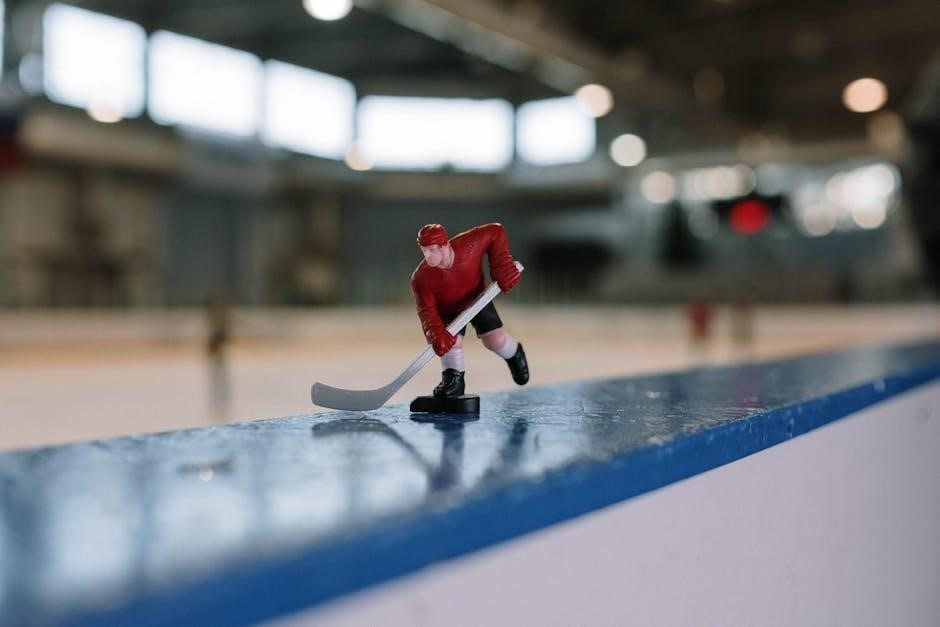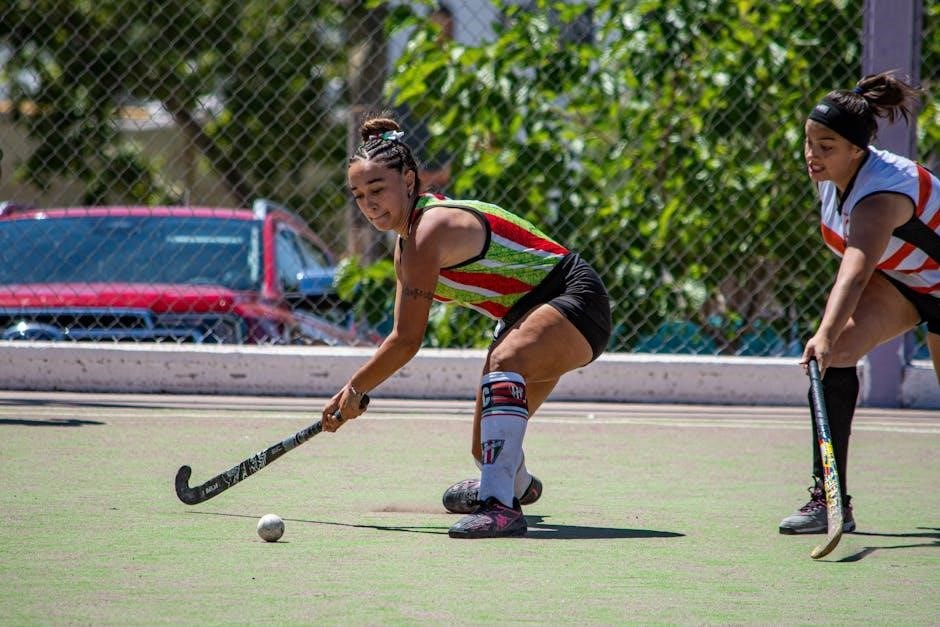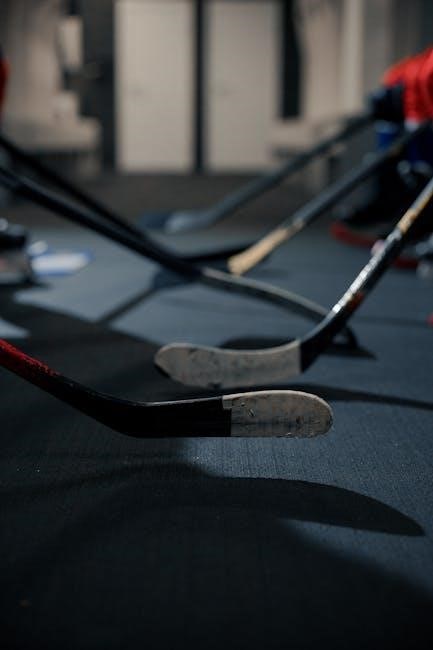Welcome to the ultimate guide on selecting the perfect field hockey stick length. Choosing the right size is crucial for optimal performance and comfort, ensuring players can maneuver effectively on the field.
1.1 Importance of Proper Stick Length
Proper stick length is essential for optimal performance, as it directly impacts control, technique, and comfort. A well-fitted stick ensures better ball handling, precise passing, and powerful shots. Incorrect length can lead to discomfort, reduced accuracy, and even penalties for not meeting regulations. Finding the right size is crucial for players of all skill levels to maximize their game.

1.2 Overview of Factors Influencing Stick Length
Stick length is determined by a combination of player height, position, skill level, and personal preference. Player height is a primary factor, with taller players requiring longer sticks. Position on the field also plays a role, as forwards and midfielders may prefer different lengths than defenders or goalies. Skill level and personal comfort further refine the selection process, ensuring optimal performance and ease of handling.

Factors Influencing Field Hockey Stick Length
Player height, position, skill level, and personal preference are key factors influencing stick length. These elements ensure optimal performance, comfort, and control on the field.
2.1 Player Height and Its Impact on Stick Length
Player height is a primary factor in determining stick length. Generally, the stick should reach from the floor to the player’s hip bone or chin when standing upright. For example, players 62″ or taller typically use a 37.5″ stick, while shorter players opt for shorter lengths. This ensures proper control and maneuverability during gameplay, with personal preference slightly adjusting the fit.
2.2 Role and Position on the Field
A player’s position significantly influences stick length. Forwards and midfielders often prefer shorter sticks for agility and ball control, while defenders may opt for slightly longer sticks for reach and power. Goalies use specialized sticks designed for blocking, typically shorter and thicker. Each position requires a stick tailored to its demands, ensuring optimal performance and effectiveness during gameplay.
2.3 Skill Level and Playing Style
Players with advanced skills may prefer longer sticks for greater reach and power, while beginners often benefit from shorter sticks for better control. Stick length should align with a player’s technique, allowing for effective dribbling, passing, and shooting. A well-suited stick length enhances performance, making it easier to master essential skills and adapt to various playing styles efficiently.
2.4 Personal Preference and Comfort
Personal preference and comfort play a significant role in choosing the ideal stick length. While height and position provide a foundation, individual comfort can influence the final decision. Players may prefer a slightly longer or shorter stick based on their handling style, balance, and ease of movement. Ensuring the stick feels natural and comfortable is essential for peak performance and enjoyment of the game.

How to Measure the Correct Stick Length
Measuring the correct stick length involves standing upright with shoes on. The stick should reach just below your hip bone for optimal control and comfort.
3.1 Standing Position Measurement
Stand upright with your shoes on and hold the stick vertically beside you. The stick’s top should reach just below your hip bone for optimal control and comfort during play.
3.2 Measuring Against the Body
Stand with the stick placed vertically alongside your body, wearing your shoes. The top of the handle should reach just below your hip bone for proper fit. Ensure the stick feels balanced and comfortable, allowing easy control during gameplay.
3.3 Handling and Comfort Check
Once measured, hold the stick to assess its feel. The handle should fit comfortably in your grip, allowing smooth control. Ensure the stick isn’t too heavy, as this can tire you quickly. The bow and balance should suit your playing style, enabling precise ball control and maneuverability during gameplay.

Field Hockey Stick Size Chart
This chart provides a detailed guide to selecting the ideal stick length based on player height and position. Typical lengths range from 28 to 38 inches, ensuring optimal performance for all players.
4;1 Youth Stick Sizes
For younger players, stick lengths typically range from 28 to 32 inches. These sizes correspond to player heights of 122-138 cm, ensuring proper control and handling. The smaller dimensions allow for easier maneuverability, helping young players develop their skills effectively. Stick size charts often recommend specific lengths based on age and height to ensure a comfortable fit and optimal performance.
4.2 Intermediate Stick Sizes
Intermediate players typically use sticks ranging from 34 to 35.5 inches. These lengths suit players between 137-161 cm tall, offering a balance between power and control. This size range is ideal for those who have mastered basic skills and are transitioning to more advanced techniques, providing a comfortable fit and enhanced performance on the field.
4.3 Adult Stick Sizes
Adult field hockey sticks typically range from 36.5 to 38.5 inches. These lengths are designed for players over 161 cm tall, offering optimal performance and control. The handle length usually ranges from 12 to 14 inches, ensuring a comfortable grip and precise stickhandling. This size range is ideal for professional and experienced players seeking maximum power and accuracy in their game.

Material and Its Impact on Stick Length
Material significantly influences stick length, with carbon, fiberglass, and wood options affecting weight, flexibility, and durability. Higher carbon content often results in longer, lighter sticks for enhanced performance.
5.1 Influence of Material on Performance
Material plays a crucial role in determining stick performance, with options like carbon, fiberglass, and wood varying in weight, durability, and flexibility. Carbon sticks are lighter and more durable, often preferred for advanced play, while fiberglass and wood blends offer affordability and forgiveness for younger players. The choice of material can influence stick length preferences, impacting power, control, and maneuverability on the field.
5.2 Material Types and Their Characteristics
Field hockey sticks are made from various materials, each with unique properties; Carbon sticks are lightweight and durable, ideal for advanced players. Fiberglass sticks are durable and affordable, suitable for beginners. Wooden sticks offer better control but are heavier. Composite sticks combine materials, balancing performance and cost. Each material affects stick longevity, power, and handling, catering to different skill levels and preferences.

Skill Level Considerations
Skill level significantly impacts stick length choices. Beginners often prefer shorter sticks for better control, while advanced players opt for longer sticks to enhance reach and power.
6.1 Beginner Stick Length Recommendations
Beginners should opt for shorter sticks, typically between 28 to 32 inches, to ensure better control and easier handling. This length allows for improved technique development and maneuverability. For players under 4’10”, a 28-inch stick is ideal, while those between 4’10” and 5’4″ often prefer 30-32 inches. Personal preference and comfort should guide the final choice within this range.
6.2 Intermediate Stick Length Recommendations
Intermediate players typically benefit from sticks measuring 34 to 36.5 inches. This range offers a balance between power and control, catering to those who have mastered basic skills but are refining their techniques. Stick length should align with player height, ensuring optimal performance and comfort during gameplay, while allowing for precise stickhandling and passing abilities.
6.3 Advanced Stick Length Recommendations
Advanced players typically opt for sticks measuring 37 to 38.5 inches, tailored to their height and skill level. This range enhances power and precision, allowing for advanced techniques like drag flicks and precise passing. The stick should reach just below the hip bone, ensuring optimal control and maneuverability during high-speed gameplay.
Playing Position and Stick Length
Position influences stick length, with forwards and midfielders favoring shorter sticks for agility, while defenders opt for longer sticks for reach and power.
7.1 Forwards and Midfielders
Forwards and midfielders benefit from shorter sticks, typically between 34-36.5 inches, allowing for agility, quick stick handling, and precise ball control. This length enhances maneuverability in tight spaces, enabling faster movements and accurate passes. Players in these positions prioritize speed over reach, making shorter sticks ideal for dynamic playmaking and rapid transitions on the field.
7.2 Defenders
Defenders often prefer longer sticks, typically between 37-38.5 inches, which provide greater reach and leverage for intercepting passes and tackling. The extended length aids in defending wide spaces and clearing the ball effectively. This added reach also helps defenders maintain control and stability when using their sticks for blocks and interceptions during gameplay.
7.3 Goalies
Goalies typically use shorter sticks, around 38.5 inches, with a larger head for better blocking and control. The shorter length allows for quicker movements and precise clears, while the larger head enhances ball-stopping ability. This specialized design helps goalies maneuver effectively in confined spaces and react swiftly to incoming shots, making their stick a crucial defensive tool.
Stick Shape and Bow Type
Stick shape and bow type significantly influence performance. The M-Bow, a medium curve, enhances power and skill execution, making it ideal for players seeking balance in their game.
8.1 Popular Bow Types and Their Uses
Popular bow types include the M-Bow and J-Bow. The M-Bow offers a medium curve, enhancing power and control, while the J-Bow features a deeper curve, ideal for advanced players and specialized skills like drag flicking. Each bow type caters to different playing styles and skill levels, ensuring optimal performance on the field.
8.2 Stick Shape and Its Effect on Length
Stick shape significantly impacts length and functionality. A midi shape offers balanced control, while maxi and short sticks cater to specific skills. The shape affects handling and power, with longer sticks enhancing reach and shorter ones improving maneuverability. Players choose shapes based on their role and style, ensuring optimal performance and comfort on the field.

Official Regulations
Official regulations ensure fair play and safety in field hockey. The FIH sets strict standards for stick dimensions and materials. Compliance is essential for legal play.
9.1 Handle Length and Width
The International Hockey Federation (FIH) regulates handle dimensions. Adult sticks typically have a handle length of 12-14 inches (30.5-35.6 cm) and a width of 1.2 inches (3.0 cm). These standards ensure consistency and safety, allowing players to maintain proper control and technique. Junior sticks may have slightly smaller dimensions, but all must comply with FIH guidelines to be legal for play.
9.2 Overall Stick Dimensions
The overall length of a field hockey stick typically ranges from 28 to 38 inches, including both handle and head. FIH regulations specify that the stick should reach the top of the hip bone when standing. Taller players often opt for longer sticks, while shorter players prefer shorter lengths for better control and maneuverability.

Personal Preference and Customization
Personal preference plays a significant role in choosing stick length, with customization options available to ensure the stick fits individual player needs for comfort and performance.
10.1 Customizing Stick Length
Customizing stick length involves adjusting the height to fit the player’s body, ensuring the top of the stick reaches just below the hip bone for optimal control and maneuverability. This adjustment allows for personalized fit, enhancing performance and comfort during gameplay, while also catering to individual preferences and playing styles effectively.
10.2 Ensuring Proper Fit
Ensuring proper fit involves measuring the stick’s length against the player’s height, typically from the ground to just below the hip bone. This ensures optimal control, balance, and comfort during gameplay. A well-fitted stick enhances performance, allowing for precise ball control and effective stickhandling, while reducing fatigue and improving overall playing experience.
Selecting the right field hockey stick length is vital for performance and comfort. Consider height, position, and personal preference to optimize your game. Use this guide to find your perfect fit and elevate your play.
11.1 Summary of Key Points
Proper stick length is crucial for performance and comfort. Factors like height, position, and skill level influence the ideal size. Materials such as carbon and fiberglass also impact stick durability and performance. Always consider personal preference and ensure the stick fits comfortably, as this enhances control and effectiveness during gameplay. Refer to size charts for precise measurements tailored to your needs. Stick length should not compromise mobility or skill execution, so prioritize the right fit to optimize your field hockey experience.
11.2 Final Tips for Choosing the Right Stick
Test the stick in person to ensure comfort and control. Consider your position and playing style for optimal length and shape. Seek advice from experts or senior players for personalized recommendations. Ensure the stick meets official regulations for your league. Prioritize a balance between length and maneuverability to enhance performance. Always choose a stick that feels right for you.